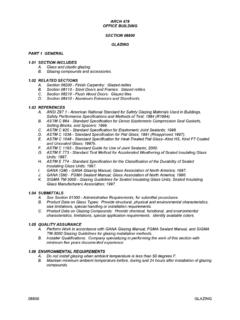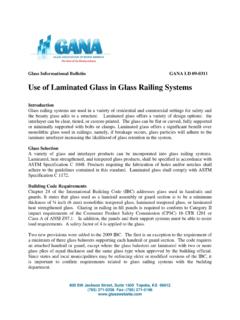Transcription of Recommended Applications for Heat-Treated Glass
1 800 SW Jackson Street, Suite 1500 Topeka, KS 66612 (785) 271-0208 Fax: (785) 271-0166 Glass Informational Bulletin GANA TD 07-0114 Recommended Applications for Heat-Treated Glass The Glass industry has been heat treating architectural Glass to increase its strength since about 1930. The process of heat - treating Glass involves uniformly heating Glass close to its softening temperature and then rapidly, and uniformly, cooling it. This process results in the development of surface compressive stresses, thus increasing the strength of the Glass . Heat-Treated Glass is used in many of today s architectural glazing Applications where increased strength to resist Glass breakage is desired. Vision and spandrel areas of buildings as well as building entrances, Glass railings and balustrades, and other Applications where public safety is a priority, are common examples. Types of Heat-Treated Glass There are two types of Heat-Treated Glass : heat -strengthened Glass and fully tempered Glass .
2 Both are produced in a similar fashion by heating and cooling the Glass . It is the rate of cooling that determines whether the final product is heat -strengthened or fully tempered. It is a generally accepted rule of thumb that Glass that has been heat -strengthened has approximately twice the breakage strength of annealed Glass of the same thickness and that fully tempered Glass has approximately four times the breakage strength of annealed Glass . The North American industry standard specification for Heat-Treated Glass is ASTM C1048 Standard Specification for heat -Strengthened and Fully Tempered Flat Glass . heat -strengthened Glass is defined as having a surface compression of 3,500 to 7,500 psi (24 to 52 MPa); no requirement for edge compression is specified. Fully tempered Glass is defined as having a minimum surface compression of 10,000 psi (69 MPa), an edge compression of not less than 9,700 psi (67 MPa), or meeting the American National Standards Institute (ANSI) Standard - Safety Performance Specifications and Methods of Test for Safety glazing Materials Used in Building1or the Consumer Product Safety Commission (CPSC) Standard 16 CFR 1201 - Safety Standard for Architectural glazing Materials2 Category II Because of the high internal stresses in both Glass types, all fabrication including cutting, hole-drilling, notching, or edge treatment must be performed prior to the Glass being Heat-Treated .
3 GANA TD 07-0114 2 Reasons for heat - Treating The reasons for heat -treating Glass are two-fold: increase the Glass strength to resist externally applied loads and, for fully tempered Glass , also to meet safety glazing requirements defined by applicable codes or federal standards. External loads include wind and snow loads as well as thermal stresses induced by the sun s radiant energy. In many instances, combinations of these loads must be considered by the design professional during the design process. Commonly available software tools are available for the responsible design professional to evaluate the breakage performance characteristics of both heat -strengthened and fully tempered Glass , and compliance with ASTM E1300 Standard Practice for Determining Load Resistance of Glass in Buildings. Both heat -strengthened and fully tempered Glass can significantly reduce the potential for Glass breakage due to uniformly applied wind and snow loads as well as from thermal stresses.
4 Fully tempered Glass that complies with ANSI and CPSC is recognized as a safety glazing material. Federal, state, and local laws, as well as national building codes, require safety glazing wherever human impact is probable. When broken by impact, fully tempered Glass breaks into small particles, thereby reducing the potential for serious personal injury. Building codes require safety glazing in specific hazardous locations where human impact is likely. It is important to note that heat -strengthened Glass is not a safety glazing material. Glass strength is significantly reduced by Glass edge damage or poor edge quality. For Heat-Treated Glass , Glass edge damage and/or poor edge quality can offset or negate the entire benefit of heat -treating the Glass ; therefore, care must be taken through all steps of the fabrication and installation processes to keep the Glass free of damage.
5 Pros and Cons of heat treated Glass The design professional must carefully consider the performance and breakage characteristics of heat -strengthened and fully tempered Glass before selecting or specifying either Glass type. heat -Strengthened Glass : Pros: Increased resistance to wind and snow loads Increased resistance to thermal stress When broken, tends to remain in the frame until removed Virtually eliminates risk of spontaneous breakage Cons: heat -strengthened Glass is NOT A SAFETY glazing product unless laminated Increased level of optical distortion compared to annealed Glass GANA TD 07-0114 3 Fully Tempered Glass : Pros: May be fabricated to meet safety glazing requirements Increased resistance to wind and snow loads Increased resistance to thermal stress Cons: If broken, small particles, or clusters of particles, or even the majority of the lite, may easily fall out of the frame Increased level of optical distortion compared to annealed Glass Possibility of spontaneous breakage Alternatives In some instances, increasing the thickness of annealed Glass may be sufficient to meet certain uniform wind or snow load requirements without the need to heat - treat the Glass .
6 It is strongly Recommended that a comprehensive wind/snow load analysis and thermal stress analysis be conducted before making a final design decision. In addition, monolithic lites of annealed Glass of any thickness will not meet safety glazing requirements and may not provide adequate thermal stress breakage protection. As an alternative to fully tempered Glass for safety glazing Applications , laminated Glass is a consideration. Laminated Glass is a requirement for overhead glazing and should be considered for Applications where Glass fallout is a concern. heat -Strengthened Laminated Glass : Pros: Increased resistance to wind and snow loads Increased resistance to thermal stress If broken, tends to remain in the frame until removed Virtually eliminates risk of spontaneous breakage Reduced sound transmission Meets safety glazing requirements Cons: Increased level of optical distortion due to multiple lites of Heat-Treated Glass Exposed edges will show layers versus a clean monolithic edge Fully Tempered Laminated Glass : Pros: Increased resistance to wind and snow loads Increased resistance to thermal stress GANA TD 07-0114 4 Meets safety glazing requirements Improved Glass retention Reduced sound transmission Cons.
7 Possibility of spontaneous breakage Increased level of optical distortion due to multiple lites of Heat-Treated Glass Exposed edges will show layers versus a clean monolithic edge If both lites break, there is a possibility the entire laminate will fall from the opening. Guidelines for Typical Architectural glazing Applications Architectural glazing Applications use Glass as part of an overall finished product or glazing system. Whether that product is a wall system, overhead or sloped glazing system, railing system, impact rated system, etc., it is very important that all of the components including the Glass itself, are designed with the system in mind so that the finished product works as intended. There is no substitute for proper Glass design, physical testing, proper fabrication and proper installation. All of these systems must take into account both the structural performance and aesthetic characteristics of the Glass .
8 Prior to making final design decisions, the structural integrity of the system needs to be verified by a design professional. The guidelines offered below are general in nature and are not intended to replace specific and appropriate structural design/engineering practices. Vertical glazing : For vision and spandrel Applications above the ground floor, heat strengthened Glass is typically Recommended for the exterior lite of an insulating Glass unit if annealed Glass is not strong enough to resist wind load and/or thermal stresses. For Fireman knock-out (fire break-out) panels or other smoke evacuation Applications , fully tempered Glass is Recommended or required. For any safety glazing application, fully tempered or laminated Glass must be used. Overhead or Sloped glazing : When specifying insulating Glass for sloped or overhead glazing Applications , heat -strengthened laminated Glass is typically Recommended for the interior lite facing the public space.
9 heat -strengthened or fully tempered Glass may be used for the exterior, outward facing lite. Doors, Side Lites, Entrances, or other Safety glazing Applications : Fully tempered or laminated Glass that meets ANSI or CPSC specifications is required. GANA TD 07-0114 5 Balcony railings or other Applications where fallout is a concern ( where there are unprotected walking surfaces below): Laminated Glass is Recommended . heat -strengthened laminated Glass or fully tempered laminated Glass is Recommended to provide increased resistance to wind loads, thermal stresses, and impact. According to the 2012 IBC, the only exception is: Single fully tempered Glass complying with Category II of CPSC 16 CFR Part 1201 or Class A of ANSI may be used in handrails and guardrails if there is no walking surface beneath them or the walking surface is permanently protected from the risk of falling Glass .
10 Special Building Code Regions (windborne debris areas) A safety glazing and impact resistant Glass is required to meet the applicable building code requirements. Summary Heat-Treated Glass plays an important role in the long-term performance and safety of today s modern architecture. Heat-Treated Glass , including both heat -strengthened and fully tempered, increases the strength of annealed Glass to meet design loads and stresses throughout the lifetime of the building. Glass tempered to ASTM C1048 and ANSI or CPSC standards can meet the safety glazing requirements of the building codes. Depending on the specific building application, there are alternatives to monolithic Heat-Treated Glass that should be considered, especially where Glass fallout is a safety concern. Laminated Glass is required for overhead glazing Applications and, when constructed with either heat -strengthened or fully tempered Glass , will provide an increased level of strength compared to annealed laminated Glass .









